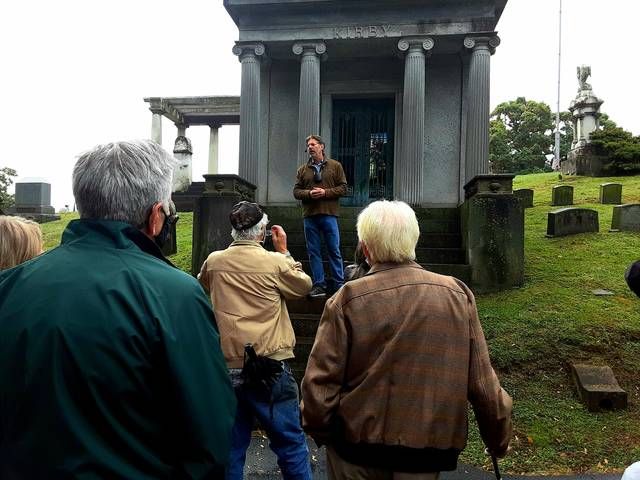Click here to subscribe today or Login.
WILKES-BARRE — A walking tour of Hollenback Cemetery on Saturday provided a chance to learn about area families which have impacted the Wyoming Valley and beyond.
Wilkes-Barre Preservation Society director and Hollenback Cemetery Association board member Tony Brooks led about 100 people through the cemetery providing historic information about the Hollenback, Butler, Ross, Conyngham and Kirby families and others, namesakes of many area landmarks.
Brooks said the Hollenback Cemetery board is an easy one to sit on because it was well endowed by the Hollenback family and others.
“It’s very well run with a great staff,” he said.
He began the tour highlighting Fred Morgan Kirby, who came to the area in the 1880s and opened a five-and-dime store. The store eventually merged with F. W. Woolworth, forming F.W. Woolworth Company.
Brooks credited Kirby with remaining a proud resident of Wilkes-Barre, even though his business often took him to New York City.
He then detailed the only two father/son mayor team from Wilkes-Barre interred at the cemetery, first detailing the tenure of Ira M. Kirkendall, who served first as the Burgess of Wilkes-Barre from 1870 to 1871 when it was a borough, and then as Mayor of the city of Wilkes-Barre from 1871 to 1874.
Ira’s son Fred Kirkendall served as mayor from 1905 to 1908.
Brooks, a long time fixture in the city’s historical landscape, led the group through the lives of more than a dozen deceased area residents as he deftly moved from grave to grave.
Robust turnout
Brooks noted that the turnout was robust in spite of some rain showers.
Allen and Penny Sabatino, from Mountain Top, are both history buffs and said they enjoy walking through cemeteries, looking at gravestones as a means of understanding family histories.
Penny Sabatino said in most cemeteries families were buried in clusters, and it was often possible to imagine the essence of a family as she looked at the gravestones.
Stephen Kotch, of Bear Creek, said he and his wife, Linda, had travelled all over the world to view historical sites, including a trip to France to see the preserved trenches of World War I.
But Kotch said the couple also enjoy local history, especially this year when COVID-19 restricted travel.
The couple are also into antiquing, which takes them across Northeastern Pennsylvania.
Kotch said that, too, has an historical element often reminding him of various tools and home goods which are no longer used, but have a story to tell.
Kathleen Smith, of the Shawnee Fort Daughters of the American Revolution, said such events are a way of transmitting an understanding of history to the next generations.
Even the graves of the most simple families, she said, often have a complex story to tell.
“And,” she added, “nobody tells it better than Tony.”







